|
 |
|
India
our tour across the country
|
 |
|
|
India - magnificent cultural
treasures and bitter poverty...
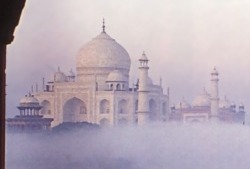 The exotic sound of Indian music from a tape which
gave us our Indian friends as well as the many beautiful photos
and videos we took in India, recall the flair of the orient and
convey a vivid picture of all the fascinating and conflicting impressions
we had on our trip. Omnipresent and unforgettable are the pictures
of the magnificent
Mogul- and Maharaja
palaces, mosques,
temples and
forts from white marble,
red sandstone and other refined material with most elaborate stonemason
works and inlays of semiprecious stone and one feels, nothing will
ever surpass the beauty of this amazing cultural heritage. Above
all the legendary Taj Mahal
is an overwhelming sight and exceeds all you ever can imagine. It's
fascination arises from the awareness, that it is a creation of
love just as from its beauty, which lies in the boldness of its
inception, the faultless architecture, the magnificence of the structure
and the sense of proportion in all its components. The layout is
superb, the setting on the banks of river Jamuna, amidst beautiful
lawns and gardens, and the construction in pure white marble are
incomparable. The Taj is as beautiful during daytime as it is in
the moon light. It is indeed the most magnificent monument and memorial
of love which mankind ever has seen! The exotic sound of Indian music from a tape which
gave us our Indian friends as well as the many beautiful photos
and videos we took in India, recall the flair of the orient and
convey a vivid picture of all the fascinating and conflicting impressions
we had on our trip. Omnipresent and unforgettable are the pictures
of the magnificent
Mogul- and Maharaja
palaces, mosques,
temples and
forts from white marble,
red sandstone and other refined material with most elaborate stonemason
works and inlays of semiprecious stone and one feels, nothing will
ever surpass the beauty of this amazing cultural heritage. Above
all the legendary Taj Mahal
is an overwhelming sight and exceeds all you ever can imagine. It's
fascination arises from the awareness, that it is a creation of
love just as from its beauty, which lies in the boldness of its
inception, the faultless architecture, the magnificence of the structure
and the sense of proportion in all its components. The layout is
superb, the setting on the banks of river Jamuna, amidst beautiful
lawns and gardens, and the construction in pure white marble are
incomparable. The Taj is as beautiful during daytime as it is in
the moon light. It is indeed the most magnificent monument and memorial
of love which mankind ever has seen!
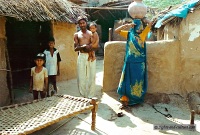 The marvelous Mogul- and Maharaja
palaces, mosques and temples are the one side and the real reason
to visit India, however the real life presents a very different
picture from what the normal European ever can imagine. Inseparable
from the magnificent cultural treasures through our minds and dreams
go the pictures of the unbelievable and unimaginable poverty of
so many people right around us everywhere and all day long. All
our lives we'll never forget those terrible sights. It is a very
different thing to watch the misery on TV than to experience it
in person. We did not know what it means to be faced with living
conditions of the so-called "third world". Beggars, misery and bitter
poverty wherever you go. We gave alms to handicapped people and
pleased children with sweets, balloons and bananas ... however of
course the single people can't help it. The marvelous Mogul- and Maharaja
palaces, mosques and temples are the one side and the real reason
to visit India, however the real life presents a very different
picture from what the normal European ever can imagine. Inseparable
from the magnificent cultural treasures through our minds and dreams
go the pictures of the unbelievable and unimaginable poverty of
so many people right around us everywhere and all day long. All
our lives we'll never forget those terrible sights. It is a very
different thing to watch the misery on TV than to experience it
in person. We did not know what it means to be faced with living
conditions of the so-called "third world". Beggars, misery and bitter
poverty wherever you go. We gave alms to handicapped people and
pleased children with sweets, balloons and bananas ... however of
course the single people can't help it.
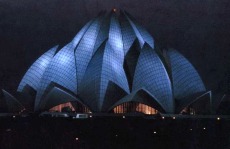 There is a very wide diversity of economic
status and education in Indian society. Just recall, that about
50% of the Indian people are illiterates while Indian computer scientists
are appreciated specialists in the sophisticated Western countries!
By the side of palatial residences one can see the crowded slums
where people live in sub human conditions. In the cities imported
cars move side by side with rickshaws. Like in economic conditions
there is also a very wide variety in customs, languages and religions
in this amazing country. There is a very wide diversity of economic
status and education in Indian society. Just recall, that about
50% of the Indian people are illiterates while Indian computer scientists
are appreciated specialists in the sophisticated Western countries!
By the side of palatial residences one can see the crowded slums
where people live in sub human conditions. In the cities imported
cars move side by side with rickshaws. Like in economic conditions
there is also a very wide variety in customs, languages and religions
in this amazing country.
So despite the great diversity India
is one Nation with an amazing potential. However it will take a
long time and need more international support to create dignified
living conditions for all people in this vast country.
top / bottom
|
|
Hinduism - religion is way of life
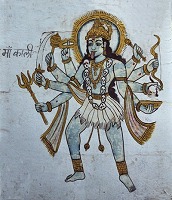 In India religion is way of life. It is an integral
part of the entire Indian culture and permeates every aspect of
life. Hinduism is the dominant faith, practiced by over 80% of the
population. But India is a secular state. People of many religions
freely live here. Hindu Religion is the most peaceful religion I
know. That's why Hinduism can be passed only by birth and thus there
are no missionaries who try to convert people to this religion. In India religion is way of life. It is an integral
part of the entire Indian culture and permeates every aspect of
life. Hinduism is the dominant faith, practiced by over 80% of the
population. But India is a secular state. People of many religions
freely live here. Hindu Religion is the most peaceful religion I
know. That's why Hinduism can be passed only by birth and thus there
are no missionaries who try to convert people to this religion.
Hindu religious thought is based on the "Vedas". In fact the
name of the religion truly is "Vaidic" religion and not "Hindu"
religion. The name Hindu came to be attached because the people
practicing it were living on the banks of river Sindhu then. The
"Vedas" were written down in Sanskrit about 3000 years ago and give
a detailed description of customs and belief of the "Aryas" who
settled India in those days. They are considered to be one of the
earliest literary works of mankind. For Hinduism the "Vedas" are
the scriptures incorporating the science of living as revealed to
the sages in the state of deep meditation .
The Hindu believes, that each being has an immortal soul, which
will migrate to another body after death. Rebirth (reincarnation)
can happen in form of any creature. That's why faithful Hindus are
strict vegetarians. The Hindu understands his present state - sickness
and misery as well as health and prosperity - as a deserved consequence
of the good or bad deeds in his previous life. Thus he would not
envy someone his fortune or complain about his bad luck . A handicapped
Hindu said: "I don't know what I have done in my previous life but
I have to suffer for it now". This philosophy of Karma should encourage
him to be virtuous.
The visit with our Indian friend and our observations in the
different temples and especially at the banks of the Ganges in Varanasi
(Benares) gave us deep insides in the spiritual world of Hinduism
and lead us to a better understanding of this belief. It is unimaginable
how strongly Hinduism determines people's life with all the rites
as for example daily worshipping different deities at the domestic
altar. The domestic altar is a "must" in each home but as well in
public establishments like shops, restaurants etc. Such an altar
mostly consists of a board on which are placed small statues of
the different deities, decorated with flowers, an oil lamp and religious
pictures.
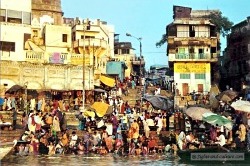 One hardly can get a true picture of Hinduism without
having been to Varanasi
(Benares), which is the most important place of pilgrimage for Hindus.
Countless temples and places of cult give the place an unchangeable
face. Each Hindu at least once in his life should go to Varanasi
to take a holy bath in "Mother Ganges" and to pray to Lord Shiva,
the creator of universe (see picture above). This bath is a spiritual
act with special rites. It will purify his soul from sins and is
an important step on the way to his ultimate goal - to enter the
Nirvana, which means the salvation from the cycle of birth, death
and rebirth and ultimately to be one with the almighty God, the
creator. Varanasi is also a favorite place to die, as Hindus believe,
that one who dies at Varanasi gains salvation automatically, such
is the greatness of this place! There are ritual cremations on pyres
(for affluent people from Sandle wood) and in crematoria each night.
All Hindus desire, that no matter where they die, at least their
ashes will be merged in the sacred waters of Mother Ganga, who in
Hindu's belief in her immense love for her children will bring salvation
from the trauma of the cycle of birth, death and rebirth One hardly can get a true picture of Hinduism without
having been to Varanasi
(Benares), which is the most important place of pilgrimage for Hindus.
Countless temples and places of cult give the place an unchangeable
face. Each Hindu at least once in his life should go to Varanasi
to take a holy bath in "Mother Ganges" and to pray to Lord Shiva,
the creator of universe (see picture above). This bath is a spiritual
act with special rites. It will purify his soul from sins and is
an important step on the way to his ultimate goal - to enter the
Nirvana, which means the salvation from the cycle of birth, death
and rebirth and ultimately to be one with the almighty God, the
creator. Varanasi is also a favorite place to die, as Hindus believe,
that one who dies at Varanasi gains salvation automatically, such
is the greatness of this place! There are ritual cremations on pyres
(for affluent people from Sandle wood) and in crematoria each night.
All Hindus desire, that no matter where they die, at least their
ashes will be merged in the sacred waters of Mother Ganga, who in
Hindu's belief in her immense love for her children will bring salvation
from the trauma of the cycle of birth, death and rebirth
top / bottom
|
Traditional clothing.....
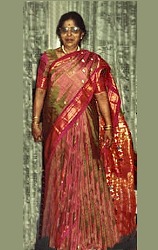 Most impressive
and charming is the colorful traditional clothing of all the women,
especially in the country Rajasthan. They wear their saris each
day, even while working in the field (see chapter "experiences in
the country" and
related site). Most impressive
and charming is the colorful traditional clothing of all the women,
especially in the country Rajasthan. They wear their saris each
day, even while working in the field (see chapter "experiences in
the country" and
related site).
The sari is a 6 m long and 2 m broad scarf and sure it demands
some skill to dress oneself with it. It is available in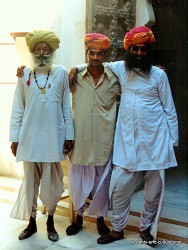 different
materials (cotton, synthetic, silk...) accordingly to the intended
purpose. For festive occasions there are precious, elaborate, handmade
saris from pure. finest silk with golden threads in marvelous designs.
The Indian women have an amazing sense for tasteful clothing and
pay attention that all the accessories like bangles and the point
on the forehead match in color with the sari. The festive saris
are incredible beautiful and the women make a charming sight! Such
valuable handmade pieces are very expensive in relation to an average
income in India. However men spend much money to dress their wives
and sisters accordingly to their social position. different
materials (cotton, synthetic, silk...) accordingly to the intended
purpose. For festive occasions there are precious, elaborate, handmade
saris from pure. finest silk with golden threads in marvelous designs.
The Indian women have an amazing sense for tasteful clothing and
pay attention that all the accessories like bangles and the point
on the forehead match in color with the sari. The festive saris
are incredible beautiful and the women make a charming sight! Such
valuable handmade pieces are very expensive in relation to an average
income in India. However men spend much money to dress their wives
and sisters accordingly to their social position.
The
traditional clothing of men consists of long wide shirts and trousers
from different materials, beginning with simple cotton up to fine
pure silk, according to the occasion. In Rajasthan some men by tradition
wear a great looking twisted mustache and sometimes a turban. However,
men dressed like on the picture are seldom. To see a festive dressed
family see picture under the chapter "Diwali".
top / bottom
|
Diwali, the happiest festival in Hinduism
 If you ever
go to India you should do it around Dusherba/Diwali in October.
We had the unique fortune to share Diwali with our Indian friends
and owe to them the happiest days of our trip as well as unforgettable
beautiful experiences. Diwali is the festival of lights, celebrated
all overIndia, to commemorate the victory of Lord Rama over demon
King Ravana. The festival denotes, that truth always triumphes over
the evil. This is the happiest festival of Hindu calendar. At night
countless oil lamps light Rama the way home from his period of exile.
Today the festival is also dedicated to Lakshmi and to Kali in Calcutta.
The picture shows the family of our friend's son on Diwali in festive
traditional clothing eating sweets. If you ever
go to India you should do it around Dusherba/Diwali in October.
We had the unique fortune to share Diwali with our Indian friends
and owe to them the happiest days of our trip as well as unforgettable
beautiful experiences. Diwali is the festival of lights, celebrated
all overIndia, to commemorate the victory of Lord Rama over demon
King Ravana. The festival denotes, that truth always triumphes over
the evil. This is the happiest festival of Hindu calendar. At night
countless oil lamps light Rama the way home from his period of exile.
Today the festival is also dedicated to Lakshmi and to Kali in Calcutta.
The picture shows the family of our friend's son on Diwali in festive
traditional clothing eating sweets.
All in all the festival lasts for five
days.
On the first day The houses
are thoroughly cleaned and the door steps are decorated with intricate
rangolis [chalk design].
Day two is dedicated to Krishna's
victory over Narakasur, a legendary tyrant, in South India on this
day, a pre dawn bath is followed by donning of new clothes. By custom
you have to take a pre dawn bath because it is said, that angels,
Gods etc. roam on earth in the pre sunrise time.
Day three is known as
Diwali, Deepawali Lakshmi,Puja, the goddess of fortune. It
is the most important day of the festival. with meeting friends
and family and exchanging sweets. Traditionally this is the
beginning of new financial year for the companies.
Day four commemorates the
visit of the friendly demon bali whom Lord Vishnu put in his place.
On day five men visit their
sisters to have a tika put on their head (tika is an application
of red vermilion on the forehead. Hindus apply it).
Exchanging sweets has become a part of tradition as well as lighting
of oil lamps. Diwali marks also the beginning of the New Year in
North India, which is welcomed with crackers and street fireworks
like everywhere in the world.
top / bottom
|
|
Indian traffic - an unimaginable experience...
Actual the travel agent and my Indian pen pals warned against
the long rides by car through the country - they would be too stressing
and tiring but they were next to the sights and the place of pilgrimage,
Varanasi (Benares), the most interesting and informative part of
this trip. They gave us unique experiences and unforgettable impressions
of Indian life, living conditions and culture.
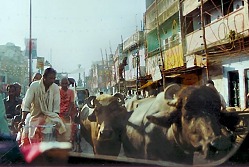 The Indian
traffic is the most incredible experience you can have as a European
road user. No matter if you are in an old city or ride through the
country you share the road with camel carts, hand pulled fruit carts,
thousands of bicycles, hundreds of rikshas as well as with free
living pigs, cows, dogs and sheep. In this way the speed limits
itself in the towns of 10-15 km/h and on the roads outside of about
45 km/h..... The picture shows a view from the rear window of our
car of the traffic in Varanasi. A motorbike is used for as many
as 4 people as we watched and so it goes for example for a family:
behind the driver (father) a child and at the end of the seat sitting
across the mother, dressed with her sari holding a child on her
lap. The Indian
traffic is the most incredible experience you can have as a European
road user. No matter if you are in an old city or ride through the
country you share the road with camel carts, hand pulled fruit carts,
thousands of bicycles, hundreds of rikshas as well as with free
living pigs, cows, dogs and sheep. In this way the speed limits
itself in the towns of 10-15 km/h and on the roads outside of about
45 km/h..... The picture shows a view from the rear window of our
car of the traffic in Varanasi. A motorbike is used for as many
as 4 people as we watched and so it goes for example for a family:
behind the driver (father) a child and at the end of the seat sitting
across the mother, dressed with her sari holding a child on her
lap.
Except for the younger districts of the big cities we didn't
see any traffic signs like for right of way. The cars as a whole
have no outside rear-view mirror and usually one does not use blinkers.
There is only one simple rule: you have to watch the traffic in
front and to show with your hand if you want to turn off to another
direction - the drivers behind you will realize this and be careful...
The most important part of the car is the horn - how else could
the driver in front know, that you intend to pass and how else could
you push him or get him to make way for you?
top / bottom
|
|
Experiences in the country
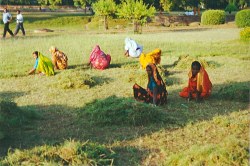 On our long way through the country by plain, train
and more than 1000 km by car, we contacted many people and found
them very friendly, no matter where we stayed. English is understood
almost everywhere and especially the children and youngsters liked
a small talk. Mainly they wanted to know, where we came from and
if we liked India and were happy to get a confirmation. On our long way through the country by plain, train
and more than 1000 km by car, we contacted many people and found
them very friendly, no matter where we stayed. English is understood
almost everywhere and especially the children and youngsters liked
a small talk. Mainly they wanted to know, where we came from and
if we liked India and were happy to get a confirmation.
The villages are usually cleaner than the old districts of the
cities and we were pleasantly surprised to see, that people
in the country
were amazingly well dressed. With their colorful traditional clothing
the woman decorate like flowers the countryside (see chapter "traditional
clothing"). The picture shows girls and woman cutting the lawn in
the temple garden of Sarnath (near Varanasi). It is the very normal
way to do this work - no lawn mower! It gives them the chance to
earn some Rupies.
 The more we penetrated into
the interior the more we asked ourselves in which age we were stepping
back. People live like centuries ago and time seems to stand still
there. The small houses often are made from loam with thatched roofs
and small openings for the windows. The equipment is accordingly
poor and mainly consists of a kind of handmade camp beds from wood
and hemp. Often there is no water and no electricity. So the woman
fetch water from a well and The more we penetrated into
the interior the more we asked ourselves in which age we were stepping
back. People live like centuries ago and time seems to stand still
there. The small houses often are made from loam with thatched roofs
and small openings for the windows. The equipment is accordingly
poor and mainly consists of a kind of handmade camp beds from wood
and hemp. Often there is no water and no electricity. So the woman
fetch water from a well and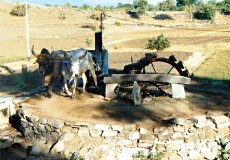 carry it in globular vessels, so-called
"matkas", from clay or brass on their heads to their homes as they
carry
everything on their heads. If you watch them as they walk in their
beautiful saris they truly have a kingly appearance (see chapter
about traditional clothing). We have the deepest respect for those
people, who despite of their poverty keep their self-respect and
sense for beauty. However, beggars are everywhere...
carry it in globular vessels, so-called
"matkas", from clay or brass on their heads to their homes as they
carry
everything on their heads. If you watch them as they walk in their
beautiful saris they truly have a kingly appearance (see chapter
about traditional clothing). We have the deepest respect for those
people, who despite of their poverty keep their self-respect and
sense for beauty. However, beggars are everywhere...
Most interesting for us was a stop
at the "Persian wheel", an irrigation system which is famous in
north India. At the wheel is fixed a long chain with cans, which
scoop the water out of the well into a duct . It works with ox power.
top / bottom
|
|
Castes, an elementary part of Hindu social structure
A special social feature in Hinduism is the classification of
people through a system of castes, which was already described about
3000 years ago in the "Vedas" (see chapter about Hinduism). Basically
the castes were assigned accordingly to one's occupation. Through
passage of time however, the affiliation to a caste began to be
irrevocably decided by one's birth. The castes as an elementary
part of Hindu social structure control the living together among
people and in this way their entire lives.
The main castes and their original assignments in Hindu society
are:
1. Brahmans (priest)
Hindu priests don't preach in the temples
like one knows it from Christian churches but have to enlighten
the fellow beings and perform religious functions. They are considered
the Gurus or teachers and are respected by all. Brahmins do not
aim at riches. Theirs is a life of simplicity ,reflecting the principles
of Hindu religion.
2. Warriors
Warriors are the nobility.
They are supposed to protect the subjects from enemies and to administer
the state.
3. Peasants, merchants
4. Workman, Servants
Amongst these castes there are many sub castes, based on more
finer division of the duties. Thus in the servants caste, those
who did the dirty work came to be "untouchables" though the religion
does not deprecate them only because of their low occupation. They
don't belong to any caste and form the lowest stratum of the society.
In the past they were absolutely without rights and had to suffer
the hardest fate. Many social workers fought for their justice including
Mahatma Gandhi, who called them "children of God" and tried to integrate
them into the society. However only under the reign of Nehru the
discrimination was abrogated by law, but this has not necessarily
changed the traditional opinion among the people and thus most of
them live under sub human conditions.
In the Modern society the social system has undergone considerable
changes and the name of the caste not in the least has anything
to do with the professional development of the people. Thus our
driver and the rickshaw driver proudly pointed out to us, that they
would belong to the caste of the warriors, which is to make out
by the word "singh" as a part of their name. Even if the castes
were officially abolished by the Indian republic many years ago
they form the Indian society still today, at least on the personal
side. Sure this system will survive still some further generations
as for the Hindu it is a question of the ritual purity and now as
ever parents choose for their marriageable children a partner only
within their caste (see chapter
Indian wedding).
top |
|
|